County Board Holds Final Meeting of 2022; Approves Additional Funding Distribution to Towns, Cities
BALLSTON SPA —The Saratoga County Board of Supervisors staged their final regularly scheduled meeting of the calendar year on Dec. 20 at the county complex in Ballston Spa.
The county announced it anticipates receiving approximately $22 million in sales tax revenue above the $141 million it had budgeted for this calendar year. The “robust” sales tax revenue year comes atop what was a conservatively estimated 2022 amount, County Administrator Steve Bulger said.
The Board subsequently approved its’ Law and Finance Committee recommendation to appropriate $5 million to county municipalities, which will be proportionally distributed in accordance with the Saratoga County Sales Tax formula. As such, the towns receiving the largest amount of the distribution are Clifton Park (just over $1 million), Halfmoon ($590,000), Wilton ($494,000), and Malta ($456,000). Those funds are stipulated to be used “for any lawful purpose.”
The city of Saratoga Springs, while not a participant in the County Sales Tax formula, will receive $300,000 for projects to be proposed by Supervisors Tara Gaston and Matt Veitch, and approved by the county Law and Finance Committee
Additional Actions
• The Saratoga County Board of Supervisors approved a declaration to act as Lead Agency for the proposed construction of the “New Fixed Base Operator Terminal Building” at the Saratoga County Airport, and issued a “Negative Declaration” under SEQR to indicate the proposed project and actions will not result in any significant environmental impact.
The project proposal includes the demolition of existing Hangar 1, redevelopment of the entrance corridor and existing parking area, the construction of a new terminal and the rehabilitation of the apron connecting to the new terminal building. That new terminal is slated to include waiting areas, concession spaces, conference space, and a pilot lounge area. A solar panel array will be installed on the hangar portion of the new terminal building.
•The city of Saratoga Springs sent a brief correspondence to the county requesting the Board contact the NY State Liquor Authority with the request that current county bar closing times be changed from 4 a.m. to 2 a.m. The correspondence was read aloud during the county meeting. There was no board response to the city’s correspondence and the suggestion was not brought to the floor as a resolution.
•The Board authorized the acceptance of a 2022 Domestic Terrorism Prevention Grant for $172,413 from the NYS Division of Homeland Security and Emergency Services. The grant covers the period between Sept. 1, 2022 and Aug. 31, 2024. According to the resolution, the funds will be used to support the county’s capability to prevent targeted violence and domestic terrorism through the use of Threat Assessment and Management, or TAM teams, and the development of comprehensive domestic terrorism plans.
•The Board approved the use of $85,000 from the county fund balance to increase the payments of a currently existing agreement for the purchase, training and maintenance of body-worn and in-car cameras, and Taser equipment for the Saratoga County Sheriff’s Office. In total, those new agreement terms are to be: $830,948.81 for the term May 1, 2022 through April 30, 2023, and $561,147.74 per year for the 4 years beginning on May 1, 2023 and continuing through April 30, 2027.
• In 2020, the county Board authorized a “trial” Alternative Work Arrangement Policy for certain Departments whose operational duties are capable of being performed outside of the normal work hours. This week, the county approved reported that feedback from departments to the Human Resources Department indicated that implementation of the trial Alternative Work Arrangement Policy returned positive impacts on county operations. Following the recommendations of the director of Human Resources, the Board approved the policy be adopted and that it no longer be considered as a trial policy.
The policy – while not appropriate for all Saratoga County departments - may be applicable to those where an alternative work arrangement is feasible and appropriate, and where an employee’s standard workday may be flexed due to employee needs and/or the operational efficiency of a department, according to the resolution. The total number of employee work hours in the work week as well as the compensation will remain the same as is currently. Employees interested in applying for the procedure must make a written request to their respective department head; that department head will ultimately decide whether to grant or deny the request. The goal of the Alternative Work Arrangement Policy is to assist the county in recruiting and retaining a diverse and talented workforce, and improve productivity amongst employees, according to the county.
Last Call 2AM Saratoga Approves Early Bar Closing
SARATOGA SPRINGS — Following a lengthy discussion which pushed this week’s City Council meeting close to the midnight hour, officials approved a measure moving forward that directs the city attorney petition the N.Y. State Liquor Authority to prohibit the sale of alcohol after 2 a.m. for any new city establishment seeking to secure a liquor license, or for any currently existing business seeking a license renewal.
Citing public safety reasons as its inspiration to roll back bar closing times from 4 a.m. to 2 a.m., the resolution passed by a 3-2 vote. Mayor Ron Kim, and Commissioners Jim Montagnino and Minita Sanghvi voted to approve the measure; Commissioners Jason Golub and Dillon Moran voted against.
The adopted resolution specifically directs the City Attorney to petition the SLA when “an establishment, individual or entity of any kind seeks a liquor license, seeks renewal of a liquor license, or seeks modification or amendment of a liquor license,” to prohibit the sale of alcohol by that entity beyond 2 a.m. as a condition of the granting of a license.
“The State Liquor Authority not only has the discretion to issue conditions on the granting of licenses, but (the SLA) is responsive to community requests regarding those conditions,” said Public Safety Commissioner Jim Montagnino, who authored the city measure.
The city process under the resolution seems clear regarding new businesses seeking licenses for the first time, however, appears a bit murkier when related to existing businesses seeking license renewal.
“It’s my understanding that new applications are treated somewhat differently than renewals by the SLA – new applications are given more scrutiny,” Montagnino said. On-premises wine and liquor licenses are issued for two years, according to the SLA.
“With regard to the renewals, generally, unless there are problems with the application or the applicant, the renewals are granted. I would note that in the event of a renewal application for premises that have had problems in the past…I think the SLA would take a little harder look and maybe exercise their discretion,” Montagnino said. “In a situation where there were previous problems, the SLA may be more receptive…in the case of a renewal we would review the history of that establishment from the time of its last renewal and may add information in our letter to the SLA for them to use in exercising their discretion.”
Several attempts made by the current, as well as previous councils to alter bar closing hours have been unsuccessful. One clear path to altering the time of a “last call” requires the approval of the county Board of Supervisors for the change be implemented countywide, and to subsequently forward that request to the State Liquor Authority to ultimately rule on the matter. The city resolution presented this week documents the county’s reluctance to do so, noting: “the County has, to this time, not acceded to the City’s request.”
The term of license depends on the type of license you have. If you have a retail license to sell only beer for on-premises or off-premises consumption, your license lasts for three years. Off-premises liquor and wine licenses (liquor and wine stores) are also issued for three years. If you have a seasonal license, it must be renewed every year.
In response to an inquiry of general practices, the State Liquor Authority responded via email with the following statement:
“About our licensing processes: Each and every on premises businesses – including those currently operating in Saratoga – is required at the time of application to provide notice of at least 30 days to the municipality in which it intends to operate. This allows the municipality time to provide the SLA with any desired input into the business’ operation. A municipality’s choice not to provide input generally signifies agreement with the business and business model proposed in the municipal notice. If however the municipality provides input opposing the proposed business or their method of operation, the SLA will place the new business’ application on a Board agenda, so that the positions of the business and the municipality may be heard by the SLA Full Board.
“The Full Board reviews each application on a case-by-case basis, weighing the merits of the individual application while placing due weight on the recommendations of local law enforcement, municipal officials, and members of the community.”
Last Call - What’s Next for Local Bars
SARATOGA SPRINGS — In the aftermath of a 3 a.m. shooting on Nov. 20 during which three people were injured in the Saratoga Springs’ downtown bar district, some city officials have identified altering bar closing times as a preventative measure that would assist the public’s safety.
Doing so, however, will not be an easy task.
Currently, bars in approximately two dozen of the state’s 62 counties may stay open until 4 a.m. – Saratoga County among them. Altering the closing time – city officials appear to favor a 2 a.m. closing – would require the county Board of Supervisors give their approval of an earlier closing to be implemented countywide, and to forward that request to the State Liquor Authority to ultimately rule on the matter.
Previous councils in Saratoga Springs have initiated that process three different times in recent years, with the county board either refusing to agree, or turning a deaf ear to those requests.
“When it comes to the issue of bar closing times in our city, there has been a long-standing debate about what we should do,” Matt Veitch told the City Council during its Dec. 6 meeting. It was a meeting during which the council voted down a proposed amendment that threatened to revoke the permits of bars and cabarets should their patrons become engaged in any criminal offense after 2 a.m.
Veitch serves on the 23-member Saratoga County Board of Supervisors and is specifically one of two supervisors elected to represent the city of Saratoga Springs, which in county weighted-vote terms indicates the representation of just over 14,000 residents.
“I don’t see the county (Board of Supervisors) going for a 2 a.m. bar closing county-wide,” Veitch said. “I do see them supporting the city and looking to change that on their own.”
Veitch added that during the city’s most recent attempt to alter closing times, made last year, the county’s legislative committee “rather than forwarding the request to the State Liquor Authority to change the bar closing times or to stop the item, moved an item on the county’s legislative agenda urging the state to allow for more local control of this issue. Rather than having this done on a countywide basis, basically change the state laws to allow the Liquor Authority to accept changes of bar closing times from any county, town, city or village that requests it.”
Veitch likened it to the state’s recent cannabis legislation which allows individual municipalities to opt-in or out, and more akin to the Municipal Home Rule Law – which would allow local governments to set the parameters for their own respective municipalities.
“Give localities the power to make their own decisions. This is how bar closing times were handled in the state until about the 1990s,” he said. “I will admit it is a long-term process and one that probably is a longshot in succeeding, but it is one I know the county is willing and work to support the city on.”
The majority of the state’s 62 counties have earlier than 4 a.m. closing times, “so, counties have acted,” Saratoga Springs Mayor Ron Kim said.
In late September 2013, bars in Warren County went to an earlier closing time, from 4 a.m. to 3 a.m., after state regulators unanimously approved a proposal submitted by Warren County’s board of supervisors. Then-Glens Falls Mayor Jack Diamond made the initial call for action after a series of violent, late-night incidents in the city’s South Street district, an area with a handful of bars and nightclubs, as reported by Lucas Willard of WAMC. Diamond had originally proposed a closing time of 2 a.m. to County government, but that proposal was met with opposition.
Among the state’s counties more highly populated that Saratoga, Monroe County - population 750,000, and Onondaga County - 470,000, both have 2 a.m. weekday closing times. Many other counties have set their respective earlier closing times at 1, or 2, or 3 a.m.
“We are the largest city in this county, we pay a ton of taxes that support the county, and yet they’ve punted on this issue,” Mayor Kim said, expressing frustration that the county board’s lack of agreement to a countywide 2 a.m. closing would push the city down a more difficult path in pursuit of its goal. “Changing at the county level would be much easier than going to (the state) Albany and trying to change it, because then we have to deal with Manhattan, we have to deal with all sorts of larger cities. And that’s essentially what the county is saying: We’ll help you get down to Albany. Well, I know how to get to Albany. The problem is it’s very unlikely we’re going to get Albany to listen to us.”
Legislative bodies aside, the desire of an earlier closing also faces resistance from some downtown operators. Kelsey McPartland, owner of Lucy’s Bar on Caroline Street, said a closing modification that would require a “last call” at 2 a.m. would result in a net loss of $24,000, while a 1:15 last call requiring the premises be vacant by 2 a.m. would result in a loss of more than $40,000.
Saratoga Springs City Police Chief Shane Crooks forwarded a letter to the council which explained his preference of an earlier closing time and reported on 2021 data collected by the police department that shows the necessary use of force - either in the making arrests or in separating of combatants – peak at the hour between 2 am and 3 am in Saratoga Springs.
“Between 1 a.m. and 5 a.m. is the peak for calls for service and use of force,” added city Public Safety Commissioner Jim Montagnino. “It’s been years, if not decades of inaction, and we’ve reached a point where we had a shoot-out on Broadway and we still have not taken any concrete step to try and change the situation.”
Mayor Kim said while discussions were routinely held regarding downtown safety during his previous tenure as city Public Safety Commissioner from 2005-2009, he didn’t recall discussions that informed about people who were armed with guns. “So, something has changed fundamentally down there. If we take no action, we will be blamed for that failure,” Kim said. “We need to do something, and I believe that if the City Council doesn’t, we will be held responsible down the road.”
Council members agreed they will continue to seek methods to alter the city’s 4 a.m. bar closing time to address late night/ early morning public safety concerns, particularly during weekends. City officials expressed the desire to approach the Saratoga County Board of Supervisors with their request. The county board holds its final meeting of the calendar year at 4 p.m. on Tuesday, Dec. 20 at the county complex in Ballston Spa. The last regularly scheduled City Council meeting of the year will be held at 7 later that same evening, at City Hall in Saratoga Springs.
New York State Restaurants, Bars and Taverns
Alcohol may be sold for on-premises consumption up to (typically excludes Sundays and some holidays).
1 a.m.: Broome (Saturdays: 3 a.m.), Chemung, Chenango (Saturdays: 3 a.m.), Ontario (Saturdays: 2 a.m.), Otsego (Saturdays: 2 a.m.), Schuyler, Seneca (Fridays, Saturdays: 2 a.m.), Steuben, Tioga (Saturdays: 2 a.m.), Tompkins, Yates.
2 a.m.: Allegany, Cattaraugus, Cayuga, Chautauqua, Clinton, Cortland, Genesee, Hamilton, Herkimer, Jefferson, Lewis, Livingston, Madison, Monroe, Niagara (Fridays, Saturdays: 3 a.m.), Oneida, Onondaga, Orleans, Oswego, St. Lawrence, Wayne, Wyoming (Mondays: 1 a.m.)
3 a.m.: Delaware, Essex, Franklin, Putnam, Warren.
4 a.m.: Albany, Bronx, Columbia (Saturdays: 3 a.m.), Dutchess, Erie, Fulton, Greene, Kings (Brooklyn), Montgomery, Nassau, New York (Manhattan), Orange, Queens, Rensselaer, Richmond, Rockland, Saratoga, Schenectady, Schoharie, Suffolk, Sullivan, Ulster, Washington, Westchester.
(Source: most recent data available NYS Liquor Authority).
Coming to a Mall Near You - Development Project Seeks 400 Apartments at Wilton Mall
WILTON — A proposal that would see the development of nearly 400 apartments and townhouses alongside the Wilton Mall continues to move through the town’s approval process.
The project, proposed by the Macerich Corporation and Paramount Development, includes 382 new “luxury, market-rate rental residences,” including both apartments and townhomes, and will feature “premium resident amenities with a sophisticated design,” according to the companies.
In November, the town Planning Board entertained an application to establish a Planned Unit Development District (PUDD) for a development with mixed-use, consisting of 680,000 square feet of commercial use and 382 residential units – comprised of 296 apartments and 86 townhomes. The town board is reportedly charged with making the ultimate decision regarding the PUDD, and there has been some public opposition expressed regarding the project.
A phone message seeking comment left for Town Supervisor John Lant was not returned.
Mike Shaffer, Property Manager at Wilton Mall, said this week that a project update will be provided to the Wilton Town Board during its meeting at 7 p.m. on Jan. 5. The Saratoga County Planning Board is also anticipated to provide an advisory opinion to the Wilton Town Board next month.
Considering these forthcoming recommendations of the Wilton and Saratoga County Planning Boards - as well as the anticipated Negative Declaration on SEQRA – developers are currently anticipating a Feb. 2 Public Hearing with the Wilton Town Board – the municipal entity which will decide whether the Wilton Mall Mixed-Use PUDD is ultimately approved.
Paramount Development, based in Florida, has developed 200 rental apartment communities in dozens of states. Santa Monica, California-based company Macerich has owned and operated the mall land since 2004. They own about 95 acres in all; JC Penney – owns just over two acres, and LBW Saratoga – occupied by BJ’s, owns just under four acres.
“What we see in the Wilton Mall is something that’s got some momentum. We do really well around retail,” Tom Snell, a partner with Paramount Development, told Wilton town officials during a public meeting earlier this year, when Paramount announced its plans to purchase two lots totaling just over 13-1/2 acres on the northeasterly side of the mall for the $100 million-plus project.
The potential project, which would be developed in two phases, would occur on the northeast side of the mall past Dick’s Sporting Goods, and see the removal of the former BonTon location, which closed in 2018. That was followed by the closure of Sears two years later.
Remembering Paul Schrade - 50 Years Later: Local Man Shot with RFK Reflects
The front page of the past week’s edition of this newspaper told a multitude of stories. Multimillion-dollar municipal budgets were approved. A new, local hockey team emerged with a victory in their first-ever game. Legal maneuverings are in the process of being deployed to re-adjust the timing clock and rule when city bars must close their doors, maybe.
Inside of the newspaper meanwhile, on the left-most side of page 4, smiled back a headshot photograph and a handful of paragraphs that explained Paul Hermann Schrade had died. He was 97 years old. Paul Schrade grew up in Saratoga Springs in a different time. Nearly a century later, the region, the country and the greater world-at-large have gone through a myriad of changes. Schrade has been eyewitness to some of them. If you’re not familiar, perhaps this story may help fill in some of the details.
First published in Saratoga TODAY on the 50th anniversary of Robert F. Kennedy’s death, June 2018
Paul Schrade stood atop the platform in the ballroom of the Ambassador Hotel. A few feet away, Bobby Kennedy delivered his speech.
A few hours earlier, the polls closed on the California Democratic presidential primary and the feeling of victory hung in the air. As Kennedy made his way off the stage to meet with the press, the ballroom filled with the exuberant chanting of his joy-filled supporters: RFK. RFK. RFK.
“As he walked off into the pantry area, heading for a press conference, Bobby said: ‘I want you with me,’” Schrade recalls. Once inside the hotel kitchen pantry area, he watched Kennedy extend his hand to greet workers. “Then I got hit,” Schrade says. “I started shaking violently. I didn’t even know that I’d been shot.”
Schrade was shot in the head and taken to Los Angeles’ Kaiser Hospital. Just over 24 hours later, at 1:44 a.m. on June 6, 1968, Kennedy was pronounced dead at Good Samaritan Hospital. After recovering from his injuries, Schrade moved out of Los Angeles and into the desert. He set aside the memories of that tragic night for a long time.
Paul Schrade grew up in Saratoga Springs where as a young man he worked nights and weekends at the family floral business, the descendant of which maintains the Schrade name and today stands on West Avenue as the Posie Peddler. “Slave labor,” he says with a laugh. He had a busy scholastic career that included writing for the school newspaper, Oratoga, and being involved in the speech club and photo club, among other organizations. He graduated from Saratoga Springs High School in 1942 and studied at Yale College, later becoming a union organizer and getting involved in the nation’s political scene.
During John F. Kennedy’s election campaign in 1960, Schrade struck up a friendship with J.F.K.’s younger brother, Bobby. “We had a lot of great experiences together,” he says.
The year 1968 was one of conflict in America. “Bob was facing a lot of crises,” explains Schrade. “The anti-war movement, rebellion on campuses, rebellion in the black community; Dr. King had been shot and killed. The country was in horrible shape at the point and Bob provided some hope during this terrible time.”
Vice President Hubert Humphrey would later emerge from a turbulent Democratic National Convention in Chicago to represent his party. Republican candidate Richard Nixon would win the presidency in the general election.
Asked whether he can imagine how the world might be different had Kennedy survived and been elected president, Schrade says, “well he was against the war in Vietnam. He would have ended the war.” One person’s life making such a big difference. “One small bullet made a difference,” he replied.
Sirhan Sirhan was convicted in 1969 of the assassination of Kennedy and sentenced to death in the gas chamber. The sentence was commuted three years later, when California abolished the death penalty. Sirhan became eligible for parole in 1986 but has been repeatedly rejected.
During the past several years, Schrade has re-focused his attentions on the assassination. Convinced there was a second gunman, he has been pushing for a thorough investigation. “There never was an investigation. They just grabbed Sirhan without evidence or witnesses and refused to go after the second gunman.
“I’m not going to get into conspiracy theories – whether he was programmed or not. Sirhan was there and fired (the first) two shots, missing Kennedy and shooting me. The gun was two to three feet in front of Robert Kennedy according to the prosecution’s own witnesses,” Schrade says. As he was being subdued, Sirhan wildly fired off a number of more shots. In all, six people were shot. The Los Angeles County coroner determined that three bullets struck Kennedy’s body and a fourth passed harmlessly through his clothing, CNN reported in a 2012 story sub-titled, “There Was A Second Shooter,” following a 2012 interview with Nina Rhodes-Hughes, a witness to the murder. Rhodes-Hughes said she heard two guns firing during the shooting and that authorities altered her account of the crime.
“It was an eight-shot revolver and Kennedy got shot four times in the back. Sirhan didn’t have the bullets,” Schrade says. ”He was captured out of position. The gun was two to three feet in front of Kennedy and Kennedy got hit at point-blank range in the back. It couldn’t be Sirhan. It had to be a second gunman.
“The prosecution knew this, knew there was a second gunman and didn’t do anything to investigate it. They just did a quickie on Sirhan and sent him to the gas chamber. They were going to murder this guy,” Schrade says. “It was a well-planned investigation in order to convict Sirhan. They falsified the evidence right from the beginning.”
Asked for his thoughts on motivations behind the assassination, Schrade says, “we can only guess at the motivations because we never investigated the second gunman. And I don’t guess at things anymore, only facts and truth. They decided to go after Sirhan. I don’t know why. It could have been for political reasons, but ‘why’ has not been answered.
“I’m 93. The only thing I can do at this point is make a public declaration and try to get the people that have some influence involved,” Schrade says. “Hopefully it will move these organizations to do the right thing, by Kennedy, and by Sirhan.”
City Votes Down 2 AM Bar Closing Time; Tables Salary Increase for Deputy Commissioners
SARATOGA SPRINGS — A Public Hearing on a proposed amendment that threatened to revoke the permits of bars and cabarets should their patrons become engaged in any criminal offense after 2 a.m. was staged immediately prior to the City Council’s Dec. 6 meeting. The Public Hearing, nearly one-hour long, contained many voices both in support of, and in opposition to the proposed amendment.
The council ultimately voted down the proposal 3-2 with Mayor Ron Kim and Public Safety Commissioner Jim Montagnino in favor of the measure, and Commissioners Jason Golub, Dillon Moran, and Minita Sanghvi voting against it.
Council members agreed they will continue to seek methods to alter the city’s 4 a.m. bar closing time – the preferred time appears to be 2 a.m. - to address late night/early morning public safety concerns, particularly during weekends. City officials expressed the desire to approach the county Board of Supervisors with their earlier closing request, even as previous attempts by prior councils in this manner had proved unsuccessful. The county board holds its final meeting of the calendar year at 4 p.m. on Tuesday, Dec. 20 at the county complex in Ballston Spa.
Additionally, during its four-hour full meeting this week, the council agreed to table a vote that proposed salary increases for the city’s five deputy commissioners. It is anticipated that discussion will continue at the next council Tuesday night on Dec. 20 at Saratoga Springs City Hall.
The city also agreed to send up to two council members, supporting deputy commissioners, the city attorney, and police department leadership to meet with county District Attorney Karen Heggen regarding a Temporary Restraining Order requested by the district attorney, which effectively silenced councilmembers from publicly discussing matters related to the downtown shooting that occurred in Saratoga Springs on Nov. 20. The city’s allocation of less than 3 council members ensures a quorum will not be present, so the meeting between city personnel and the district attorney may be held privately, and not attended by the public.
Look to next week’s edition of Saratoga TODAY (Dec. 16-22 edition), for a more in-depth view of what to expect at the Saratoga County Board of Supervisors and the City Council meetings that will be held at 4 p.m. and 7 p.m., respectively, on Dec. 20.
Salvation Army: Not Just Red Kettles & Holiday Bells
SARATOGA SPRINGS — Most know them for their red kettles and presence during the holiday season - but the Salvation Army, which sites its county headquarters on Woodlawn Avenue in Saratoga Springs, supports local families with a variety of programs throughout the year.
On premises there is a food pantry, and a place where after-school youth programs offer kindergartners to high school seniors help in reading, social and life skills, and the playing of musical instruments. The organization also works with thrift stores in Clifton Park, Queensbury, and Glens Falls, as well as with local agencies such as Shelters of Saratoga, and RISE.
“A lot of the people are those who just walk through the door and say: I need help,” says Lt. Michael Dow, Lt., the Corps Officer at The Salvation Army in Saratoga Springs.
“That could be physical health, mental health, food insecurities. They could need help with heating their apartment or house, with gas in their car, or getting to medical appointments. Really, it encompasses a lot, and people can walk in the door or call,” said Dow, who along with wife and fellow Salvation Army Lt. Cassidy Dow have been involved through their families with the Salvation Army since their respective childhoods.
“It runs deep in our blood,” says Dow, whose office windows face the Woodlawn Avenue parking garage, where those who are homeless often congregate. Here too, assistance is offered.
“We see things and it just hurts our hearts, but we are able to provide a meal, to provide a shower, to offer a place to come in, to help them feel safe and comfortable before they go back out on the street,” he says.
Donations to The Salvation Army Red Kettles during the holidays, meanwhile, help support many of the organization’s missions.
“Eighty-five cents of every dollar that goes in to the kettle goes right back out to the community,” Dow says.
The origin of the red kettle traces back to a December day in 1891 when Salvation Army Captain Joseph McFee sought a way to collect funds to provide a free Christmas dinner to San Francisco’s poor. McFee’s idea took off. Within four years, the kettle was used in 30 Salvation Army locations across the west coast and continued to spread globally. Red Kettles can now be found across the U.S. and Europe, Korea, Japan, Chile, and Australia.
On Friday, Dec. 9, an anonymous donor has offered to match every kettle donation locally. The red kettles are stationed at Walmart stores in Wilton and Clifton Park, Price Chopper stores on Route 50 and in Clifton Park, and along Broadway in Saratoga Springs.
The red kettles will be out through Christmas Eve. People interested in volunteering for a few hours of ringing downtown, or businesses interested in allowing a kettle to be set up can call Dow to offer their help.
“Christmastime is a huge fundraiser for the Salvation Army and everything we are able to do day-to-day Is based upon how funds are raised during this season. We are fortunate to have a community that’s so giving - although just to be honest we are a little behind in our goal this Christmas season, so any and every dollar helps,” Dow said.
The fundraising goal is $134,000 and donations may be made in person at the red kettles (where a QR Code is also available) or online through the organization’s website.
On a grand scale, the Salvation Army supports recovery efforts in national and international disasters: helping families prepare for the bitter cold in Ukraine by providing basic hygiene, warm meals, and blankets; readying dozens of mobile feeding units to mobilize across Florida during recent Hurricane Ian relief efforts, and supporting families in the aftermath of devastating floods in Pakistan.
In its fight against hunger and food insecurity, more than 56 million meals are provided annually through food pantries, meal programs, and no-cost sustainable community gardens.
It engages in anti-human trafficking efforts by providing ongoing support and services to victimized survivors, and serves displaced men, women and children with local Salvation Army homeless shelters and both transitional and permanent supportive housing programs.
The tax-exempt organization operates more than 7,000 centers in communities across the U.S., and in 2021 served more than 25 million people.
Locally, emergency programs help families pay their rent and utility bills, and through its care management program provides frequent face-to-face time with adults and kids experiencing health conditions.
The Salvation Army’s Pathway of Hope initiative provides enhanced services to families with children desiring to take action to break the cycle of crisis and intergenerational poverty. By 2030, through the Pathway of Hope, The Salvation Army says it will make a lasting difference in reducing intergenerational poverty by transforming the lives of 100,000 families in the United States.
“It’s a fantastic program,” Dow says.
=The Salvation Army of Saratoga Springs is located at 27 Woodlawn Ave., just east of Broadway and opposite the parking garage. Call 518-584-1640, or go to: https://easternusa.salvationarmy.org/empire/saratoga-springs/
Under Development: ZBA Meets Dec. 12
SARATOGA SPRINGS — The Zoning Board of Appeals will hold their next regularly scheduled meeting at 6:30 p.m. on Monday, Dec. 12, at City Hall.
Among the continued business the board may address include the seeking of an area variance to permit the construction of 102 apartment units at 131 Excelsior Area, and an area variance to permit the subdivision of an existing lot to create three lots at 190-194 Grand Ave.
In new business before the board, the owners of a single-family residence at 74 Fifth Ave. are seeking an area variance for the purposes of demolishing the existing house and the construction of a new, single-family residence.
Last Call: City Sets Tuesday Public Hearing Re: Changes to Bar Closing Times
SARATOGA SPRINGS — The City Council this week set a Public Hearing regarding efforts to change its bar and restaurant closing times from 4 a.m. to 2 a.m. The 15-minute Public Hearing will take place in advance of the council’s next regularly scheduled meeting on Tuesday, Dec. 6.
Through different administrations over the course of the past several years, the city has attempted to install earlier an earlier closing time for its downtown bars, but ultimately the county must agree for the city to be able to do so.
To the latter point, the council unanimously approved a formal letter be sent to the Saratoga County Board of Supervisors requesting prohibition of sales of alcoholic beverages for on-premises consumption after 2 a.m.
“I think this is a step that we need to make, but we need to be prepared to do more, because I don’t think it’s going to be recognized,” said city Accounts Commissioner Dillon Moran. Saratoga Springs Mayor Ron Kim agreed. “We need to leave no stone unturned in how we deal with the issues Caroline Street presents to us. Unfortunately, I don’t think the county will do this, but, yes, we need to send the letter,” said Mayor Kim.
The portion the city is requesting be changed refers to Section 17.11 of the state’s Alcohol Beverage Control Law, which states that any potential change made to restrict the hours of sale of alcoholic beverages by the state Liquor Authority must first come in the form a resolution adopted by the county board of supervisors.
$57 Million: 2023 Budget Adds 16 Firefighters
SARATOGA SPRINGS — The City Council unanimously voted to approve the adoption of a $57 million budget for 2023, during a special meeting staged Nov. 28 at City Hall.
The 2023 budget is up approximately $2.8 million compared to the adopted budget in effect during the current year.
Specifics of the spending plan include $31.3 million for personnel, which incorporates the addition of several new position across departments, and the re-addition of 6 police officers into the Department of Public Safety budget. All police officer positions are fully funded, and there is a stipulation for the hiring of 16 new firefighters. An additional $15 million has been budgeted as benefits. These include just under $10 million for healthcare, and $4.8 million in the retirement system.
Overall, personnel and benefits account for more than 80% of the annual spending plan.
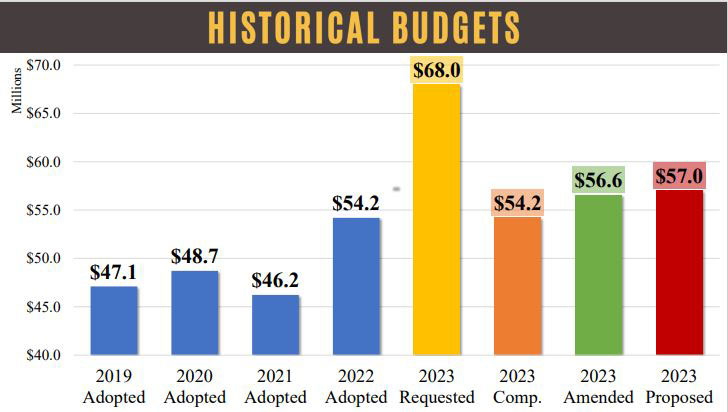
During the Public Hearing segment prior to the vote, two residents stepped forward to speak to the council.
Bill McTygue called the spending plan’s directive to add 16 new firefighters and EMS personnel as well as six police officers unprecedented when compared to previous annual city budgets. “My salute to all of you who worked together on this historic document,” McTygue said.
Gordon Boyd, the second speaker during the public hearing, echoed McTygue’s comments related to the budget, as well as complimenting council members on their transparency “in approaching justice issues,” as it related to the city’s prompt release of information and visual documents regarding a downtown shooting that occurred Nov. 20.
The early Sunday morning altercation turned into an exchange of gunfire that spilled onto Broadway and ultimately resulted in approximately 20 shots being fired. The 3 a.m. incident is believed to have begun as a verbal dispute at a bar on Caroline Street between an off-duty Sheriff’s Deputy from Vermont and a group of individuals from the Utica area, during which approximately eight shots were fired. City police officers responding to the incident fired approximately 11 shots after the off-duty deputy allegedly ignored calls to drop his weapon.
The incident marked the first discharge of a weapon in the line of duty by a Saratoga Springs officer in more than a quarter-century. City officials staged a press conference at City Hall less than 12 hours after the incident had occurred.
State Police apparently took over the investigation and a temporary restraining order was issued after Saratoga County District Attorney Karen Heggen reportedly filed a request to silence the flow of information regarding the incident, effectively gagging city officials from discussing the events further.
Regarding property taxes, the tax levy increase is 2.9%. What this means: For a home assessed value at $200,000 inside the district, the increase is about $37 per year. For home assessed value at $300,000, the increase is just under $56 per year, and at $400,000 there will be an increase of about $74.50 annually, or $6.21 per month.





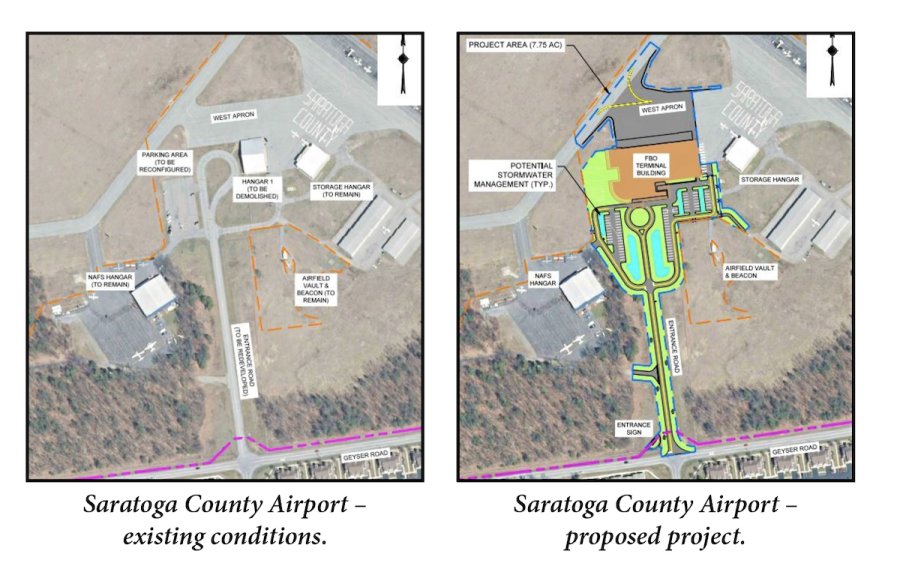

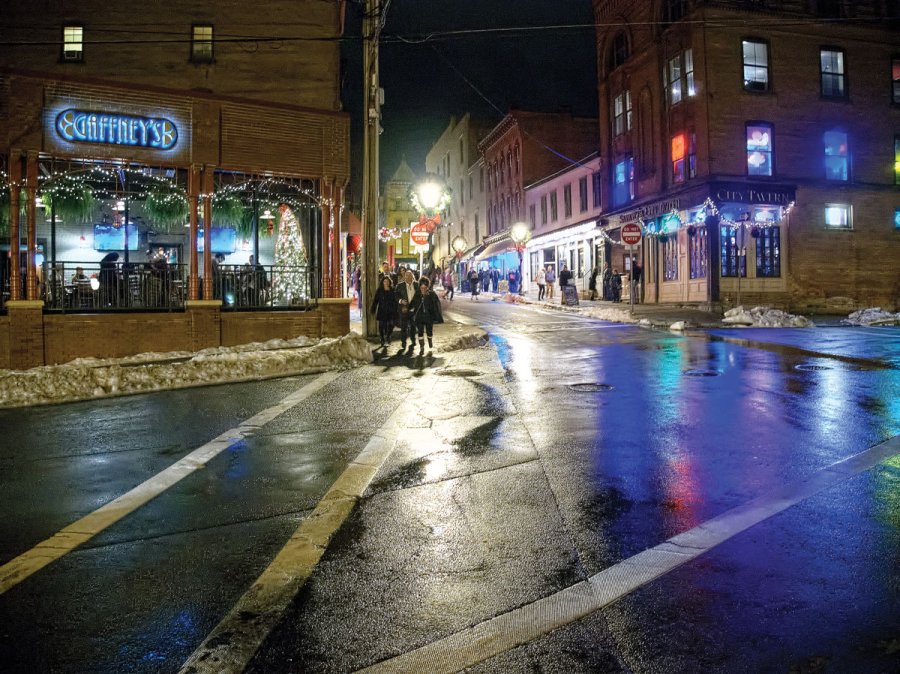

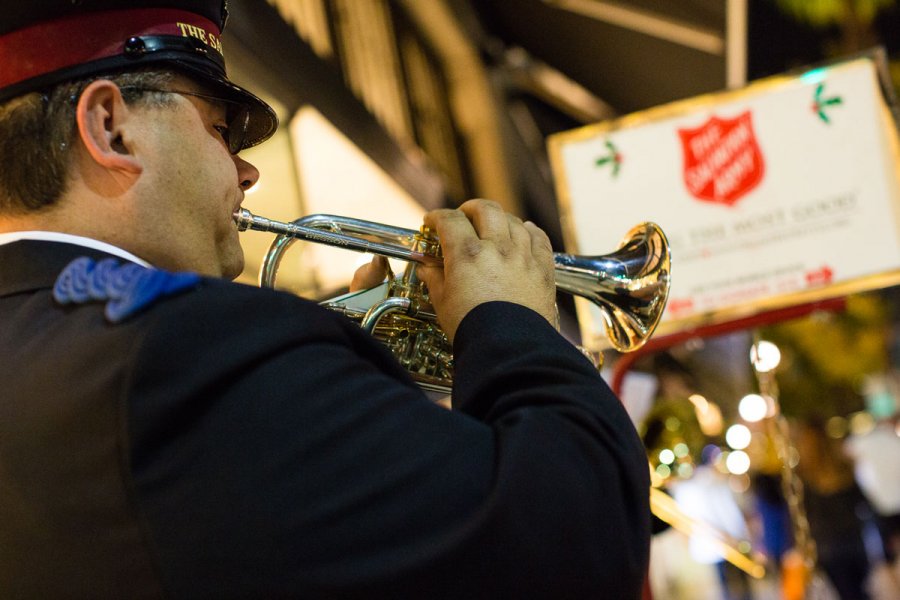
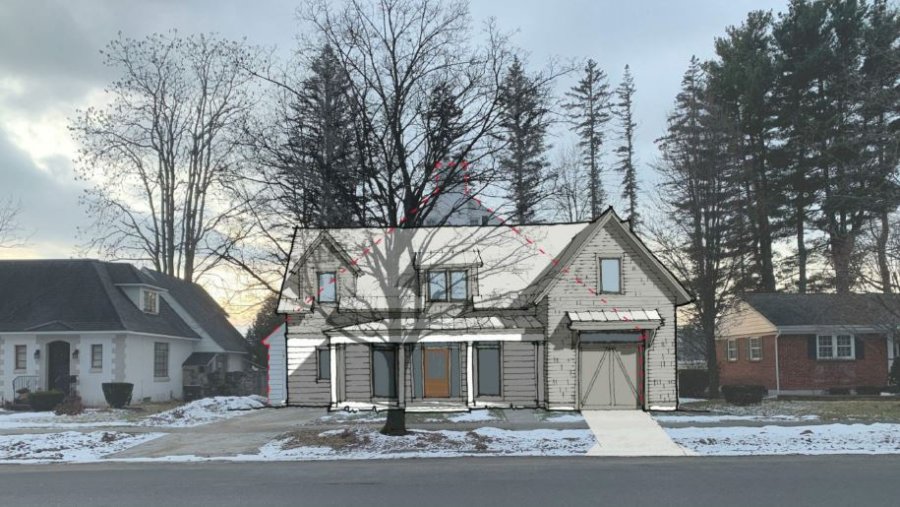
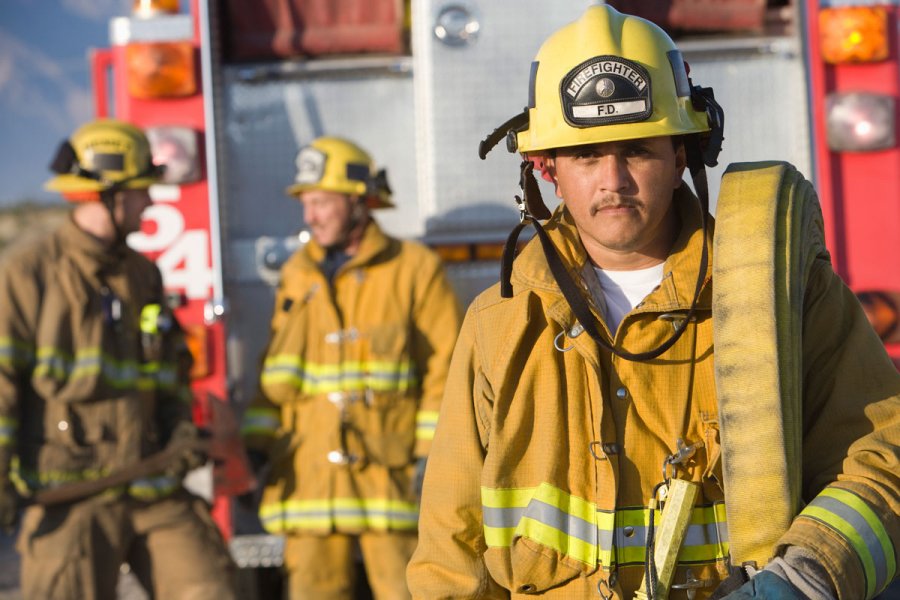







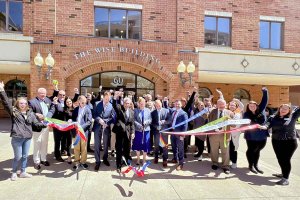



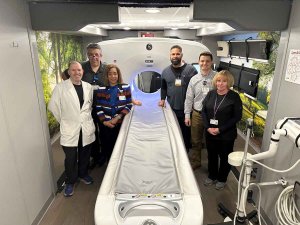










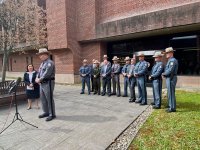


 How to resolve AdBlock issue?
How to resolve AdBlock issue? 









